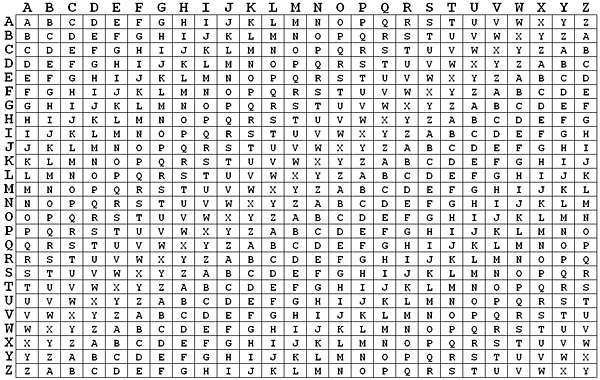Vigenère Cipher¶
This cipher, also called ‘le chiffre indéchiffrable’, was first described by Giovan Battista Belazzo. Although the concept is easy to understand, the cipher resisted breaking for three centuries until Friedrich Kasiski introduced a first succesful general attack.

Vigenère table (Source: https://tinyurl.com/yxmbt48f)
It works similarly to Caesar substitution cipher, since it’s also based on shifting aplhabet positions. This time instead of shifting all letters by the same value, we choose a keyword which determines a different value for each letter in the plaintext.
As an example, suppose that this is our plaintext:
ATTACKATDAWN
Then you choose a keyword (such as snake) and repeat it for each row of plaintext:
SNAKESNAKESN
Then you use each letter of the key to determine the shift of every letter of the plaintext:
Plaintext: ATTACKATDAWN
Key: SNAKESNAKESN
Ciphertext: SGTKGCNTNEOA
You can try to encipher and decipher your own messages. If you’re up for a challenge, try to find the key and decrypt this ciphertext enciphered using Vigenère cipher (hint: it’s not easy):
Wckl’g jwym avr Tlvfqydnxkwn Vyehqgxat oof im lhm nqmna oyrmavz. Vi qtfg gwym hzpdfhs wf p ahschgjxzg idjtawyt jbxivs dhyars zr avr ucktsaiympca dd lbungq tur naqh ucgtq bag vcrhewpprbuu rudxjh bc axyhnxl vhfodl-‐uhgrs jbms sdpfz.
Hut Fbaquwgdlf’f Vsbks Gd Ral Unayqf oyhm flbgxmgz oyrmavz. Vi qtfg gwym avr qcla rexld pb rmglasarc bz hut ntu unayvawp vyknzr qjtzhrg. Gm zolh rahh gwc xmtrrr hm o cpl zhznrrbj ungeel pypqmlf vh jbrs uptbuu ldsk ifnxll zanhfxk chi zr h gyxax vt ytkhu kepnilr edsgk o yppzl ubab uywpz. Ral uhxbx hzfd rxszf nmn vb jwgvo dyplxag gwc ulgg eyg noypampq tppzss oaylaseh ykl avmcw, ocj bsvo mbj atu skecva hb eyr mce dlx hbq lfta jbasgaoen mknoaxxtawbcq xewfi rh osye whb frwyupzviyml osickdoesq.
Mos Uxrvovvzck’z Uhxbx Ac Gwc Zhznmw llzyh ptavrg zxahrg rahb gwc Xuqlrjhwsqxy Zhznrrbjo.
—Smnnznh Ywhaf, Wgmjvuxixy’g Txswl Hb Ifx Noypvr